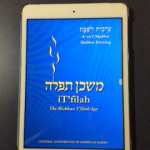 The nature of the book has changed dramatically in recent years. From the old standard of signatures of paper, in multiples of 16, 24,or 32, bound between covers and filled with typeset text, we now have ebooks, and PDF’s, and audiobooks, and apps – and that’s just for starters.
The nature of the book has changed dramatically in recent years. From the old standard of signatures of paper, in multiples of 16, 24,or 32, bound between covers and filled with typeset text, we now have ebooks, and PDF’s, and audiobooks, and apps – and that’s just for starters.
There are so many choices about how to produce a book. And yet, the essence of a book in many ways remains unchanged. They remain transmitters of ideas, containers of human experience and expression.
As a publisher, I’m often asked about how we will use technology with any given project. My answer is very simple: In as many ways as possible. For while it’s true that the technology presents us, a publisher using Hebrew text, with real challenges, and while it’s also true that we also have real financial limitations, our goal is always to create as many different versions of a book as we can, taking into account what makes sense for that particular content. For even with all the options we have available today, publishing should not be driven by technology, but rather by content development.
Publishing is no longer focused on the physical manufacturing of objects. But just as has always been true in publishing, content has to be developed carefully, thoughtfully, and creatively. That is our central goal at the CCAR Press. First we need an idea that is right for our core market, an approach that aligns with our mission, and the right team of editors and/or writers. Each project has different specifications and uses, and so allows for different formats. There are technological options we can consider today that weren’t possible last year. Surely that will be the same next year as well, and so on. Some projects, like the Daily Blessing App, are not physical books at all. Some projects, like Mishkan T’filah, exist as a physical book, an App, and in Visual T’filah, and we will continue to develop other versions as technology and finances allow. Mishkan R’fuah: Where Healing Resides, is both a physical book and an ebook. And so on.
 There’s a lot of talk in the publishing world about how people are choosing to read today. Publishers carefully study stats about how people are reading, and which demographic is doing what in which medium. But I’m not convinced it’s a competition between formats. Rather, it may be that the more formats, the more we can customize our personal reading experiences.
There’s a lot of talk in the publishing world about how people are choosing to read today. Publishers carefully study stats about how people are reading, and which demographic is doing what in which medium. But I’m not convinced it’s a competition between formats. Rather, it may be that the more formats, the more we can customize our personal reading experiences.
The other day I was listening to a book on Audible and the voice in my ear said, “In this audiobook you will learn…” which I found rather jarring. For me, the experience wasn’t about listening to an audiobook. I had simply chosen to listen to this specific book, rather than read it. I hadn’t shopped for an audiobook, I had shopped for this particular title. The fact that it was an audiobook was insignificant. The audiobook aspect of the experience was a doorway to step through, on the other side of which was the content of the book. What mattered ultimately was the content, not the format.
Growing up I learned that salad is eaten with one kind of fork, and the main course with another. Dessert might be eaten with yet another. Later I learned that fish has its own kind of fork, and even later was introduced to such specialty items as pickle forks and olive forks. Think too about glasses – this kind for water, this kind for white wine, this kind for red, and a frosted mug for beer. Each was created to best serve the experience of imbibing that particular food or drink, but in the end, the purpose is all the same: to convey the food or the liquid to your mouth.
So too with different book formats in this age of multiple choice. As a reader, I find myself choosing different formats depending on the content and context. I prefer printed books for poetry, for Torah commentaries, and for cookbooks. Yet I read fiction almost entirely on my iPad. I listen to non-fiction business books on my phone. It’s not a competition between the formats, but rather a matter of which one I prefer for the particular content.
The questions about how to best use technology in publishing are challenging and enormous. Publishers of all shapes and sizes are required to constantly keep learning new skills, and consider new options. But the core of publishing is still about content. For publishers, technology is not the goal, it is merely the means.
This blog also appeared on RavBlog, the blog of the Central Conference of American Rabbis.
